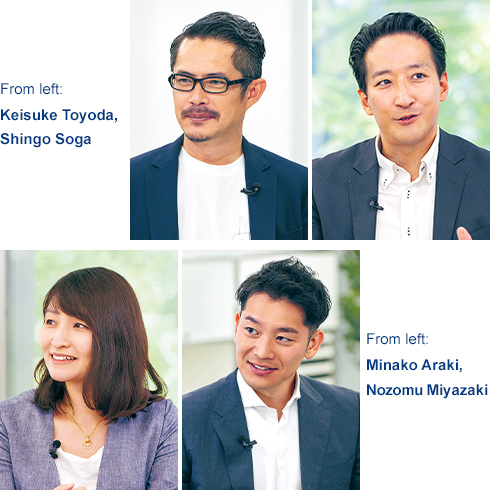Steps for the BETTER FUTURE:Addressing Local Needs and Issues to Build Smart Cities that Stand the Test of Time
Mitsubishi Corporation (MC) is currently engaged in smart-city development projects in Japan, Indonesia, Vietnam and other parts of Southeast Asia. Exactly how are these massive projects undertaken? What is the future outlook for urban development? This is the second of our three-part, roundtable discussion between architect Keisuke Toyoda and three city-building pros at MC.

Roundtable Participants
Keisuke Toyoda (architect, noiz/gluon partner, Visiting Professor at the University of Tokyo's Institute of Industrial Science); Shingo Soga (Head of Business Development Office in Mitsubishi Corporation's Urban Development Division, Urban Development Group); Minako Araki (member of the Urban Development Department in Mitsubishi Corporation's Urban Development Division, Urban Development Group); Nozomu Miyazaki (member of the Business Development Office in Mitsubishi Corporation's Urban Development Division, Urban Development Group)
- —— MC’s smart-city projects have been attracting a great deal of attention. Please tell me about your operations in Indonesia.
-
ArakiOur BSD City Project covers about 6,000 hectares just outside metropolitan Jakarta. That’s a huge area, roughly the same as that encircled by Tokyo’s Yamanote line1. More than 200 of those hectares are devoted to a new, greenfield urban development focused on creating a smart city that leverages public transportation to link and integrate a host of urban amenities, including commercial facilities, hospitals, schools and residential properties. The rest of the project’s area is dedicated to brownfield operations aimed at turning existing municipal infrastructure into “smart” infrastructure. That work involves developing an urban OS2, promoting driverless transportation and MaaS3, and otherwise initiating steady and stepwise pilot projects in many regions.
MiyazakiThe BSD City concept is that of a “Smart Digital City,” so the intent is to continue developing it through the introduction of more and more smart digital services. One such initiative took place this past spring when MC entered into a capital and business alliance with unerry, a company that manages location-based big data. If we can connect individual data on things like human movement and sales, then we should be able to disseminate detailed information that caters to the personal attributes and preferences of city dwellers, which can help us to build the most comfortable and attractive communities possible. Looking forward, we hope to work with various other businesses and bring in cutting-edge technologies that will further enhance BSD City. Ideally, we would also like to adapt this smart-city model so that it can be developed in other countries too, such as Vietnam for instance.
- —— Why has MC chosen Southeast Asia to develop its smart cities?
-
SogaSoutheast Asia is undergoing rapid urbanization and economic development, and although that is a good thing, it has also aggravated a number of societal problems, including air pollution, traffic congestion and population decline due to lower birthrates and aging societies. Smart cities seek to not only upgrade transportation, living, and other types of infrastructure, but also introduce solutions to those sorts of problems that take advantage of digital transformations (DX). By developing such cities in Southeast Asia, we feel that we can help the region both to decarbonize and address its other problems as well, not to mention make a meaningful impact on the value of its urban communities. Furthermore, many of the problems being faced in Southeast Asia today are the same as those faced by Japan in years past, so our experience and know-how can prove very beneficial I think.
ToyodaEngaging side-by-side in both greenfield and brownfield work is a key point. When building a smart city, it’s important to develop platforms that facilitate smooth, high-dimension connections between places, things and data; however, it’s unrealistic to assume that you’ll be able to start doing that immediately on a city-wide scope. First, you have to build your own, small-scale greenfield system that covers just one facility or city block, then you have to try and develop that further through brownfield acquisitions and adaptations. You then take what you learn from that and apply it to new greenfield pilot projects, and so on and so forth. This cyclical approach will help you to grow your urban developments in phases and make them increasingly integrated as you go. This is a very important process because the very idea of a smart city is to reinvent urban environments.
- —— I would imagine that differences in culture and customs present difficulties when engaging in urban development projects outside of Japan. How does MC address issues like that?
-
SogaA smart-city development is first and foremost a city-building project. If you fail to build genuine, trust-based relationships with the locals, then you can never hope to build a city that will still be standing 100 years from now. I think MC’s greatest strengths include its global network of professionals who have worked tirelessly from one generation to the next to develop businesses that are considerate of unique local needs, characteristics and environments. We have a particularly large contingent of Japanese employees posted in Indonesia, where we have lengthy track records working with local enterprises on a variety of different businesses. The knowledge and other assets that we have accumulated over the years can not only be applied to these smart-city projects, but also prove instrumental in their future growth and prosperity.


